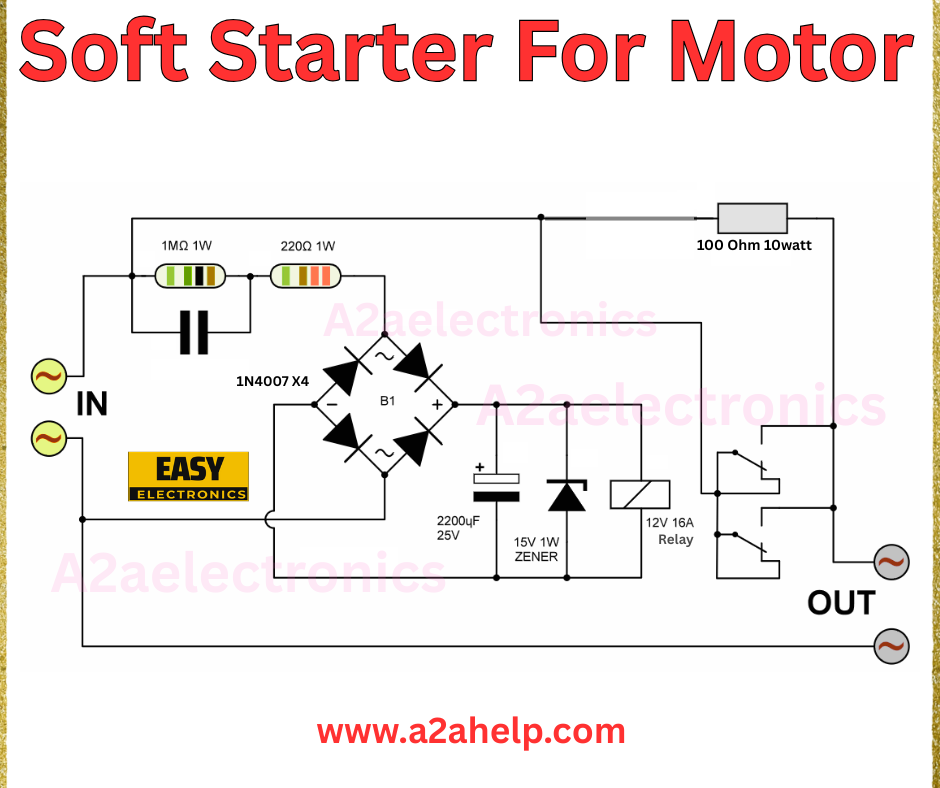Welcome to Easyelectronics, your trusted resource for all things electronics! In this article, we’ll dive into the world of soft starters for motors, exploring their design, components, and benefits. If you’re an electronics enthusiast or a professional looking to understand how to implement a soft starter, this guide is tailored for you. Let’s break down the circuit diagram provided and explain everything step-by-step.
What is a Soft Starter for Motor?
A soft starter is an electronic device used to control the voltage supplied to an electric motor during its startup phase. This helps reduce the inrush current and mechanical stress, prolonging the motor’s lifespan and ensuring smoother operation. The circuit diagram above, sourced from Easyelectronics, showcases a simple yet effective soft starter design.
Analyzing the Soft Starter Circuit Diagram
Let’s dissect the components and connections in the provided schematic to understand how this soft starter works.

Key Components
- Input (IN): The power supply enters the circuit, typically from an AC source.
- Resistors:
- Two resistors (1MΩ 1W and 220Ω 1W) are used to limit current and protect the circuit.
- A 100Ω 10W resistor is included to manage the output load.
- Diode Bridge (1N4007 x4): This forms a full-wave rectifier, converting AC to DC. The diodes (B1) ensure unidirectional current flow.
- Capacitor (2200µF 25V): Smooths the rectified DC voltage, providing a stable power supply.
- Zener Diode (15V 1W): Regulates the voltage to a constant 15V, protecting downstream components.
- Relay (12V 1A): Controls the motor’s connection to the power source, activating once the circuit stabilizes.
- Output (OUT): Delivers the controlled power to the motor.
How It Works
- The AC input is rectified by the diode bridge, converting it to DC.
- The capacitor filters the DC voltage, while the Zener diode maintains a steady 15V.
- The resistors limit the initial current, preventing damage to the motor.
- Once the voltage stabilizes, the relay switches on, allowing the motor to start smoothly.
Benefits of Using a Soft Starter
- Reduced Inrush Current: Minimizes strain on the power supply and motor.
- Extended Motor Life: Less mechanical stress leads to longer durability.
- Energy Efficiency: Optimizes power usage during startup.
- Cost-Effective: A simple design like this can be built with affordable components.
Step-by-Step Guide to Building Your Own Soft Starter
- Gather Materials: Collect the components listed in the diagram (resistors, diodes, capacitor, Zener diode, relay, etc.).
- Assemble the Circuit: Follow the schematic, ensuring correct polarity for diodes and the capacitor.
- Test the Setup: Connect to a low-power motor initially to verify functionality.
- Adjust as Needed: Fine-tune resistor values if the startup is too abrupt or slow.
Conclusion
Implementing a soft starter for your motor is a smart way to enhance performance and longevity. The circuit diagram from A2aelectronics provides a practical starting point for building your own. For more advanced designs or troubleshooting, feel free to explore our site or reach out for support. Start your electronics journey with us today!
